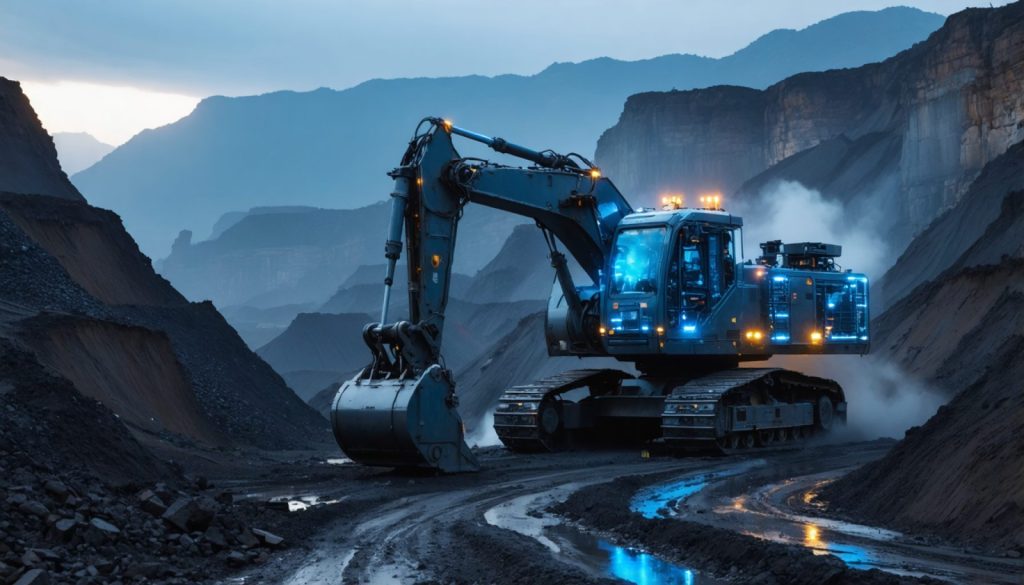
- The Dahaize Mine in Shaanxi, China, exemplifies a shift in coal mining through advanced technology, merging AI with traditional industry practices.
- Automation has significantly increased productivity, with each worker at the mine contributing nearly $1 million annually in output.
- China faces a complex challenge, balancing its position as a leader in renewable energy investments with its ongoing dependence on coal.
- The approval of 66.7 GW of new coal-fired power capacity highlights the tension between carbon emission reduction goals and energy security needs.
- The use of smart technology in mining could redefine profitability and impact labor practices globally, especially amidst wage inflation in Western economies.
- China’s current trajectory will influence global energy policies and environmental outcomes, impacting economic stability and ecological sustainability worldwide.
Vast landscapes in China’s Shaanxi province are witnessing a paradigm shift, as age-old coal mines transform into technologically advanced hubs. These are not just any mines; they are the forefront of an unprecedented fusion between artificial intelligence and the coal industry.
Behind the sleek facade of innovation at the Dahaize Mine lies an economic powerhouse. Every worker there is now responsible for almost $1 million in output annually—an astonishing feat driven largely by automation. With every seam of coal extracted more precisely, drones whizzing through tunnels, and autonomous trucks navigating dust-choked passageways, productivity has reached stratospheric levels.
Yet, this AI-driven boom in coal mining cannot be viewed in isolation. China faces a delicate balance between its status as a global leader in renewable energy investments and its deep-rooted reliance on coal. Despite pledges to curb carbon emissions, the nation approved a staggering 66.7 GW of new coal-fired power capacity in just the past year.
International observers, clamoring for a reduction in coal dependency, are left puzzled. On one hand, China is setting benchmarks in clean energy spending; on the other, it continues to prop up coal as a safety net for energy security. The global implications are profound, as China is not only the largest consumer and producer of coal but also the top emitter of carbon dioxide.
The story of Dahaize echoes beyond its tunnels and shafts; it’s a beacon of the industrial future. The mine’s success illustrates how smart technology can drive productivity and profitability, challenging traditional labor practices across the globe. As Western economies grapple with wage inflation, China’s foray into AI and automation in industries traditionally reliant on human labor sends ripples through economic landscapes worldwide.
The broader message of Dahaize mine’s transformation is clear: adaptability through technology can redefine profitability. The world watches China’s dual commitment to coal and renewables with bated breath, understanding that the decisions made today will shape not only the nation’s economy but also the planet’s future.
Revolutionizing Coal: How China’s AI Mines Transform the Energy Sector
Unpacking the AI Revolution in Mining
The transformation of coal mines in China’s Shaanxi province into cutting-edge technological hubs marks a significant milestone for the industry. Perhaps the most striking development at the Dahaize Mine is its innovative integration of artificial intelligence, increasing productivity and redefining traditional mining practices. The site now boasts remarkable economic output, with each worker facilitating nearly $1 million annually, thanks largely to automation.
How AI is Changing the Game in Coal Mining
– Precision and Safety: AI-driven software enables precise extraction of coal, minimizing waste and reducing risk. The use of drones enhances both safety and efficiency, as operators can monitor tunnels and detect issues without sending workers into potentially hazardous environments.
– Autonomous Vehicles: Self-navigating trucks transport materials through the dusty corridors more efficiently than ever, reducing human labor and increasing throughput.
– Data and Optimization: AI systems analyze vast amounts of operational data in real-time, optimizing workflows and ensuring equipment is operating at peak efficiency.
Balancing Coal Dependency with Renewable Investments
China’s ambitious AI endeavors in coal mining are set against a backdrop of contrasting energy policies. On one hand, the nation leads in renewable energy investments; on the other, it approved an additional 66.7 GW of coal-fired power in the past year. This dual path creates a complex energy strategy:
– Energy Security: Coal remains a reliable backup to renewables, ensuring energy security amid fluctuating supply from wind and solar sources.
– Economic Growth: The coal industry is crucial to sustaining economic growth in coal-dependent regions through job creation and revenue.
Controversies and Limitations
Despite the advancements, there are several pressing issues and limitations surrounding AI integration in coal mining:
– Environmental Impact: Increased coal production contradicts global climate commitments to reduce fossil fuel usage and lower carbon emissions.
– Economic Disparities: While AI reduces costs for mine operators, it may also lead to job displacement, impacting communities relying on mining for employment.
– Global Response: International pressure mounts for China to lean more into renewables, sparking debates on sustainability.
Future Predictions and Industry Trends
The use of AI in mining is expected to expand, influencing various industries reliant on manual labor. As AI technology evolves, markets will likely skew towards automation and AI-driven strategies to remain competitive.
1. Wider Adoption: Other sectors, such as agriculture and manufacturing, will likely follow mining’s lead in adopting AI to drive efficiencies.
2. Sustainability Innovations: Advances in AI could potentially support renewable energy efforts, facilitating a more balanced energy mix.
Actionable Recommendations
As industries shift towards automation, businesses can take several steps to adapt:
– Invest in Training: Develop AI training programs for current employees to safeguard against job displacement.
– Sustainability Initiatives: Businesses can mitigate environmental impacts by reinvesting profits from AI efficiencies into renewable energy projects.
– Diverse Energy Portfolios: Organizations should aim for a balanced energy mix, leveraging both AI advancements and renewable investments to ensure sustainable growth.
For more insights on technological advancements and industry trends, visit China.org.cn and Bloomberg.
By strategically embracing AI while balancing economic and environmental responsibilities, China sets a precedent for integrating technology in traditional industries for a sustainable future.



